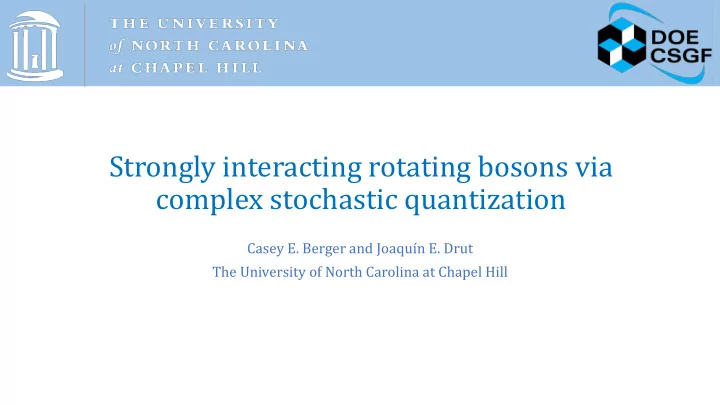

Strongly interacting rotating bosons via complex stochastic quantization Casey E. Berger and Joaquín E. Drut The University of North Carolina at Chapel Hill
Rotating Bose-Einstein condensates 1949: Onsager predicts rotating superfluids will form vortices 1979: First observation of vortices in rotating 4 He 1990s-2000s: rotating BECs in 4 He and dilute atomic gases Science 292 5516 (2001) Phys. Rev. Lett. 4 14 (1979) Advances in theory 1
Rotating Bose-Einstein condensates Theoretical advancements in study of rotating superfluids since 1950s 2
Theoretical progress • Why are we stuck? • Many-body quantum systems → Quantum Monte Carlo • Evaluate stochastically, with 3
The sign problem • Action for non-relativistic rotating bosons: • Complex action • Usual Quantum Monte Carlo methods do not work • Proposed solution: Complex Langevin Method 4
The Complex Langevin method • Generalization of stochastic quantization to complex dynamical variables • Leads to two coupled SDEs: 5
CL: success stories • Relativistic Bose gas at finite chemical potential • Lattice action • Use CL to compute density, field modulus squared Aarts, Phys. Rev. Lett (2009) 6
CL: success stories - = 0.0 7
CL: success stories - = 0.7 8
CL: success stories - = 1.125 9
CL: success stories - = 1.5 10
CL: success stories Relativistic Bose gas at finite chemical potential 4 4 6 6 4 8 4 5 10 4 0 . 40 0 . 35 4 0 . 30 0 . 25 n i Re h ˆ 0 . 20 3 0 . 15 0 . 10 2 0 . 05 0 . 00 0 . 8 0 . 9 1 . 0 1 . 1 1 . 2 1 . 3 1 0 0 . 0 0 . 2 0 . 4 0 . 6 0 . 8 1 . 0 1 . 2 1 . 4 1 . 6 µ Aarts, Phys. Rev. Lett (2009) 11
CL: success stories Density EOS of spin polarized unitary Fermi gas • -h from 0 to 2.0 (bottom to top) • Dashed lines: 3 rd order virial expansion • 3+1 dimensional lattice • Nx = 11, Nt=160 CL results show good agreement with the virial expansion in the virial region 12 Rammelmüller et al, arxiv: 1807.04664 (2018)
CL: cautionary tales • CL is not always successful • The Excursion Problem • The probability distribution is not suppressed enough for large values of the complexified variables • Causes the imaginary drift term to “run away” • The Singular Drift Problem • The probability distribution is not suppressed enough near singularities in the drift term • We don’t yet know how to prove when CL will work • Important to have checks to ensure validity • Comparisons with existing theoretical benchmarks, experimental measurements 13
Action for our system 14
CL in non-relativistic rotating bosons • Preliminary results for rotating, 2+1D system: • Average Angular Momentum dependence on rotation frequency • Nx = 12, NE = 20, E = 0.2 0 . 06 β µ = � 4 . 0 β µ = � 4 . 0 β µ = � 3 . 2 β µ = � 3 . 2 0 . 8 β µ = � 2 . 4 β µ = � 2 . 4 0 . 04 β µ = � 1 . 6 β µ = � 1 . 6 β µ = � 0 . 8 β µ = � 0 . 8 0 . 6 0 . 02 Im h L z i Re h L z i 0 . 00 0 . 4 � 0 . 02 0 . 2 � 0 . 04 0 . 0 � 0 . 06 0 . 0 0 . 5 1 . 0 1 . 5 2 . 0 2 . 5 3 . 0 0 . 0 0 . 5 1 . 0 1 . 5 2 . 0 2 . 5 3 . 0 βω z βω z 15
CL in non-relativistic rotating bosons • Preliminary results for rotating, 2+1D system: • Moment of Inertia dependence on rotation frequency • Nx = 12, NE = 20, E = 0.2 β µ = � 4 . 0 β µ = � 4 . 0 3 . 0 β µ = � 3 . 2 β µ = � 3 . 2 1 . 0 β µ = � 2 . 4 β µ = � 2 . 4 2 . 5 β µ = � 1 . 6 β µ = � 1 . 6 β µ = � 0 . 8 β µ = � 0 . 8 0 . 5 2 . 0 Im h L z / ω z i Re h L z / ω z i 0 . 0 1 . 5 � 0 . 5 1 . 0 0 . 5 � 1 . 0 0 . 0 � 1 . 5 0 . 0 0 . 5 1 . 0 1 . 5 2 . 0 2 . 5 3 . 0 0 . 0 0 . 5 1 . 0 1 . 5 2 . 0 2 . 5 3 . 0 βω z βω z 16
Future directions • Decrease |01| to study superfluid regime • Density should show triangular vortex lattice structure • We expect to see discontinuities in the circulation observable 17
Summary and Conclusions • Many systems of interest inaccessible to QMC due to sign problem • CL allows us to circumvent the sign problem • Under some circumstances, CL fails • Preliminary results for rotating non-relativistic bosons are promising • More work still to come 18
Thank you! Prof. Joaquín Drut Andrew Loheac Funding sources: Chris Shill Josh McKenney Yaqi Hou 19
Recommend
More recommend